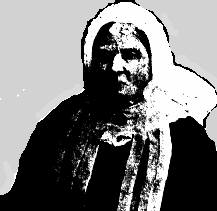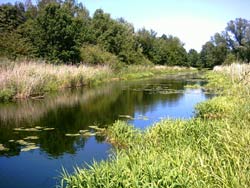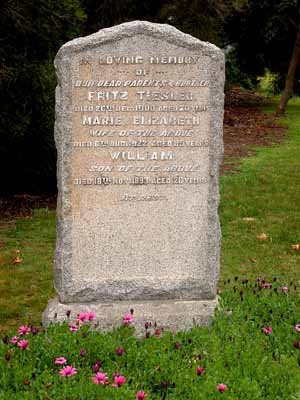| Name | Friederich "Fritz" TIESLER |
| Birth | 1830, Winzig, Silesia, Prussia, now part of southern Poland |
| Death | 25 Dec 1900, Prahran Hospital Age: 70 |
| Burial | Oakleigh |
| Father | Christian TIESLER |
| Mother | Veronica KREUZ |
| 1 | Maria FUHRMANN |
| Birth | 1832, Hamburg, Germany |
| Death | 1922, Malvern East Age: 90 |
| Father | Ferdinand FUHRMANN |
| Mother | Johanna SCHULZ |

| Children: | Matilda (1858-1937) |
| Fritz (1860-1947) | |
| Mary (1861-1933) | |
| Albertina (1866-1948) | |
| William (1867-1893) | |
| Louis (1869-1870) | |
| John (1870-1871) | |
| Winniefred May (1880-1954) |
A native of Breslau, Prussia. Friederich (Fritz) was born in 1830 and while still in his teens he joined the Army (compulsory service), in which he served for 3 years. He also trained as a carpenter, like his father, which he followed for 10 years before sailing to Australia at the age of 27 in 1857.
Winzig, Silesia, Prussia, now part of southern Poland
10 km from Oder River
Why they came?
The Lutheran church
is a "Protestant" church which developed out of the ideas of Martin
Luther. He protested in the 1520s about the way in which the Catholic church
operated in Germany at that time. He was also the first person to translate the
Bible into German, so that people could read it without having to be able to
read Latin.
The Reformed church is also based on the ideas of Martin Luther, but doesn't put as much importance on church services run according to strict worship rituals and on majestic church buildings. The organisation of their church is not so hierarchical as with the Lutherans.
Before the monarchy in Germany was abolished 1918, the state church was controlled by the government. One result was much interference by the state in the church. Confessionalism was destroyed in many churchs. by rationalism* and unionism.* In the 19th c. some Luths. organized free churchs. for the sake of confessionalism and to avoid state control. The oldest of these chs. is the Ev. Luth. (Old Luth.) Ch. (also called Breslau Syn.), which originated 1830 in Prussia when Frederick* William III ordered enforcement of the union decreed 1817 and use of a unified Agende (see also Prussian Union). In Breslau, J. G. Scheibel* refused to conform. Many church members and some pastors in Silesia joined him. Among those that joined were G. P. E. Huschke* and H. Steffens.*
For more
than 10 yrs. the Old Lutherans were persecuted by the state. Many went overseas
(see Australia, B-C; Buffalo Synod, 1). In 1845 they were granted toleration by
the "Generalkonzession" (see Frederick William IV).
However, they were also very moral and religious people and strictly maintained
the traditional practices of the Lutheran church, and didn't wish to give them
up for the Prussian king. King Friedrich Wilhelm III was a pious Christian and
member of the Reformed (Calvinist) church (his wife Luise was a Lutheran). The
big majority of his subjects in the Prussian territories were in Lutheran
congregations. Like other kings and aristocrats of that time, Friedrich Wilhelm
was also no friend of democracy, and wanted to emphasise the strong authority of
the monarchy, even in religious affairs. He decided that all Protestants in the
Prussian territories should belong to the same state church. Friedrich Wilhelm
wanted to unite the two main Protestant churches (the Lutheran church and the
[smaller] Reformed church) in a united Prussian state church. Under Friedrich
Wilhelm's supervision a new order for church services (Agende) was produced,
which all Protestants in Prussia had to use.
Some people refused to give in to this and gave passive and "spiritual"
resistance. The king made this new Lutheranism more or less a state religion and
the church pastors were in effect public servants, working for the government.
Under the law, pastors who continued to run church services using the "Old
Lutheran" prayer book and style of worship could be dismissed from their
positions (and even be put in prison), and have their property confiscated. The
minority of people wanting to hold their church services in the old Lutheran way
had to do this in secret. These people were known as Old-Lutherans. For a while,
a few pastors had to move around the country carefully, hiding from the police,
and had to hold prayer meetings for people at night in forests. Therefore these
people were keen to go to a country where they could have freedom of worship.
Religion was not their only reason for wanting to emigrate. Some of them were
motivated by economic reasons also. The population of Germany was growing
rapidly, meaning there were more people than the amount of work available, and
two very bad harvests there in 1844 and 1846 made life for poor people very
tough. The German states at that time were still pretty much a farming economy.
When the Napoleonic Wars ended in 1815, war-time markets for certain products
collapsed too, and competition from cheaper British products grew as they were
allowed into Europe again. Masses of soldiers released from German armies went
back to their farming areas and soon their was not enough viable farming land
and work to go around, especially in Prussia and south-west Germany. Prices
started to rise but wages didn't - across Germany generally wages stayed
constant between 1820 and 1850, but there was a 50% rise in the prices of basic
items like rye, potatoes and clothing.
Emigrants motivated by social reasons included those who were somewhat "speculative" in their actions; they weren't badly off at home in the German-speaking countries, yet they were curious to see if they could do better in another country like Australia - an element of adventure. This includes of course the thousands of Germans who flocked to Australia's (and particularly Victoria's) gold rushes in the second half of the 19th century. Victoria in particular saw a massive increase in the number of immigrants from German-speaking countries as thousands of adventurers arrived. By 1861 there were 10,418 German-born people in Victoria. According to the Victorian census of 1854, 41.76% of the Germans in the colony were on the goldfields; Germans were the third-largest ethnic group on the Victorian goldfields after the British and the Chinese.
How they came to Australia
The Old-Lutherans applied to the Prussian government for permission to emigrate,
but the government delayed for two years. The emigrants again and again put in
new applications and tried to explain as humbly as possible why they wanted to
leave. George Angas sent his secretary Charles Flaxman to Prussia to try to
persuade the authorities to issue emigration permits. It is not clear whether
the Prussian Government's reluctance to issue visas was due to real concern
about the fate of the emigrants in travelling to a far-away, pretty unknown
continent (this is what the Government officials often emphasised), or due to
the Government's irritation at the stubbornness of the Old-Lutherans, whose
emigration might make the world think that Prussia was oppressing people's
religious beliefs


Friedrich-Wilhelm-Canal German River Barge
Eventually permission was given. The emigrants had to travel to the port of
Hamburg from their inland villages by barge along rivers, as railways had not
yet been built. These barges were commonly called Oder barges. The journey along
four different rivers (Oder, Spree, Havel and Elbe) and on the
Friedrich-Wilhelm-Canal that connected the Oder and the Spree rivers, was about
600 km long and took three weeks. The following map shows the route they took:

From Brandenburg to Hamburg harbour
(from: David Schubert, "Kavel's People", 1997)
Emigrant Dairy description of Barge journey to Hamburg
| Saturday, 1st May | After many delays the day of assembly was fixed on this day. The meeting place would be Tschicherzig, using three barges on the River Oder to transport the emigrants to the port of Hamburg. The people from Posen boarded a barge; those from Zullichau and Schwiebus and Meseritz in Posen the second, and the third was filled with emigrants from Grunberg Province Silesia, totaling about 270. The journey was some 600km along the rivers and connecting canals of eastern and central Germany, following the route taken by their follow believers in 1838. |
| Thursday 6th May | the barges left, amid loud prayers and hymns, for fear of the police was no longer necessary. |
| 10th May | the barges turned into the Friedrich Wilhelm Canal, a channel about 25km long linking the Oder and Spree rivers. Progress was slow, because the canal was less than 9.5 metres wide at the bottom and only 1.5 metres deep. They negotiated seven locks as they were lifted a total of 18 metres up the Spree. |
| 13th May | reached Berlin, then on into the Havel and to Potsdam. |
| Wednesday 19th May | Reached Wittenberg on the Elbe - the last Prussian town, and paid their export dues. |
| Saturday 22nd | May the barges arrived in Hamburg at 7.00 pm. |
While they waited in Hamburg to be able to board their ship for Australia, many
of the Hamburg locals were curious about them and what they were doing, leaving
Germany for the other side of the world because of their beliefs. A Hamburg
Senator, Hudtwalcker, was impressed by them and wrote a description of Kavel's
people in a newspaper.
Arrival in Australia
Fritz arrived aboard the Dorothea, a relatively small ship of
386 tons on the 27th September 1857. The following year he married
Maria Fuhrmann in the Melbourne Lutheran Church. Maria had been on the same ship
from Germany as Fritz. In that year their
first child Matilda was born in Mordialloc followed by Fritz in 1860
In 1861 the family moved to State Street East Oakleigh, where Mary,
an unnamed child (stillborn), Albertina, William, Louis, John and Winniefred were born.
The property was ideally located for the transport of farm
produce to the rapidly developing Melbourne or Oakleigh. Major trade
and produce wagons passed them on Ferntree Gully Road and postal and
transport services which were not common were here frequently
available. The start at Oakleigh was not to be an easy one though.
The winter of 1862 was a long, cold and wet one. Then in late spring
there was a sudden change to hot, dry weather, with no more rain until
march 1863. Prices in the markets, in there turn, fluctuated as wildly
as the weather. Around Christmas time, the few cabbages not burnt off
by the drought were sold for ten or even twelve shillings a dozen.
When the March rains finally brought on a glut, prices fell to one
shilling a dozen. Diseases like rust, and sudden plagues of insects,
flourished in the extreme conditions.
It was recorded that Fritz also
built and operated Victoria's first Merry Go Round at Mordialloc Beach. The
Merry Go Round was re-locatable and could be loaded onto wagons and taken home. Fritz's skill as a carpenter would have made the construction an easier task.
See Family Squabble Article Here
"FATAL ACCIDENT" from the Oakleigh & Caulfield Times, December, 1900
On Tuesday last a sad accident occurred, resulting in the death of Mr Fritz Tiesler and injuries to his wife and daughter. It appears that on Christmas morning his son-in-law, Bernard (Berand) Hansen, drove over from Murrumbeena to take the old couple back to dinner with his family. He was driving a high-spirited horse, which behaved in a restive manner while the vehicle was standing outside. Having assisted Mr & Mrs Tiesler into the buggy, Hansen was climbing in after them when the horse took fright, and after nearly kicking the vehicle to pieces, bolted down the road. Hansen was thrown off the step and slightly injured, and the horse careered wildly along till an obstacle caused the vehicle to overturn and the occupants were thrown out. Mr Tiesler was severely injured, and was taken to the Alfred Hospital with a broken leg and other injuries. He did not rally from the shock, and died at the hospital the following afternoon. Mrs Tiesler received a kick on the head, which rendered her unconscious, and Miss Tiesler was severely bruised and received an ankle sprain. Mr Tiesler, who was 70 years of age, was an old, well-known and highly respected resident. Hard-working and persevering, he was one of those who are the backbone of any country. He was the oldest merry-go-round proprietor in the colony, relinquishing that avocation about 17 years ago. His funeral was largely attended by local residents.

Old Oakleigh Cemetery Memorial